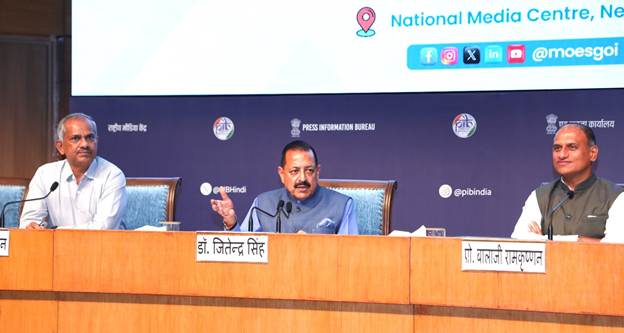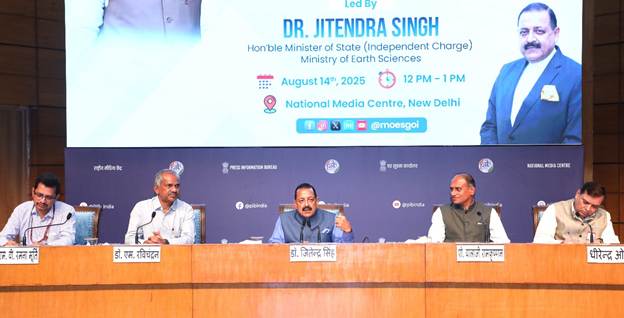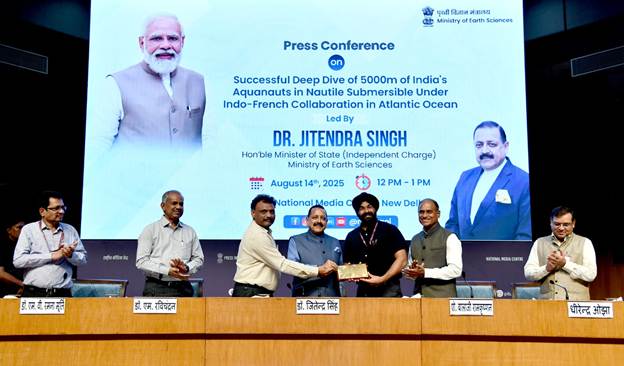Union Minister Dr. Jitendra Singh hails India’s first ever two aquanauts Cdr. Jatinder Pal Singh and Sh. Raju Ramesh deep dive upto 5000m in Deep Sea
Union Minister Dr. Jitendra Singh hails India’s first ever two aquanauts Cdr. Jatinder Pal Singh and Sh. Raju Ramesh deep dive upto 5000m in Deep Sea
Union Minister of State (Independent Charge) for Science & Technology; Minister of State PMO, Personnel, Public Grievances, Pensions, Atomic Energy and Space, Dr. Jitendra Singh, announced that on August 5 and 6, 2025, two Indian aquanauts successfully conducted deep ocean expeditions to depths of 4,025 meters and 5,002 meters in the Atlantic Ocean—marking the first time India has achieved such a feat.
The Indian aquanauts – Raju Ramesh, Senior Scientist and Cdr. Jatinder Pal Singh (Retd)—completed the maiden dives for a total duration of about seven hours, gathering valuable experience and observations before making a safe return to the surface.
Addressing the media, Dr. Jitendra Singh said that India now joins an elite group of fewer than half a dozen nations to have ventured so deep into the ocean. The expedition was conducted as a collaborative scientific activity with IFREMER, the French marine research institute, in deep waters of the Atlantic Ocean, onboard IFREMER’s submersible Nautile. This record-setting dive is a prelude to the activities under India’s Samudrayan Mission, which aims to send three aquanauts to a depth of 6,000 meters in the indigenously developed submersible MATSYA-6000 by 2027.
Samudrayan is part of the Government of India’s flagship Deep Ocean Mission, launched to explore and sustainably harness deep ocean resources. Dr. Singh expressed personal pride in Cdr. Jatinder Pal Singh’s achievement, noting that he hails from Jammu—”a son of my neighbourhood achieving this for India is a personal moment of pride,” he said.
Dr. Jitendra Singh also pointed out that this achievement comes barely four weeks after Indian astronaut Shubhanshu Shukla successfully reached and returned from the International Space Station as part of the AXIOM-4 mission. “With Indians now having made successful maiden trips to both the International Space Station and the deep ocean, we have demonstrated our scientific ambition, prowess, and mettle—moving closer to the vision of a Viksit Bharat as envisaged by Prime Minister Narendra Modi,” he said.
The Earth Sciences Minister recalled Prime Minister Narendra Modi’s patronage and priority accorded to the mission, noting that the Prime Minister Narendra Modi had highlighted it in his Independence Day addresses from the ramparts of the Red Fort in 2021 and 2023. He underlined that oceans and space will be the twin pillars of India’s future economic growth and vital contributors to the nation’s aspiration to become the world’s leading economy.Dr. Singh particularly mentioned that in both missions, India has been offered collaboration, and now we beckon the world for futuristic missions, no longer mere followers but leaders in the field.
Dr. Jitendra Singh highlighted that India, with a coastline of 11,098 km and a vast Exclusive Economic Zone (EEZ), holds immense potential for both living and non-living marine resources—offering a natural advantage unmatched by any other country. He called for concerted efforts to explore and tap these unexplored resources to add value to the economy, particularly through the development of the blue economy. He further noted that India has already signed a contract with the International Seabed Authority for exploring deep-sea minerals at depths ranging from 4,000 to 5,500 meters.
The two Indian aquanauts are from the National Institute of Ocean Technology (NIOT), Chennai, an institute under the Ministry of Earth Sciences entrusted with developing MATSYA-6000. With this submersible, India will become the sixth nation in the world to have developed its own deep-ocean human submersible.
MATSYA-6000—a first-of-its-kind, fourth-generation scientific submersible—is designed for an operational endurance of 12 hours and an emergency endurance of up to 96 hours. It features state-of-the-art systems such as a high-density Li-Po battery, underwater acoustic telephone, drop-weight emergency escape mechanisms, and bio-vests for crew safety and health monitoring.
The MATSYA-6000 completed successful wet trials at L&T Shipyard, Kattupalli, Tamil Nadu in January–February 2025 and is expected to undertake 500-meter shallow water trials by 2026.
The NIOT five-member team—comprising Sh. Palaniappan, Dr. D. Sathianarayanan, and Sh. G. Harikrishnan, led by Dr. Ramesh Sethuraman, Scientist G & Group Head for MATSYA-6000—boarded L’Atalante, IFREMER’s research ship, on August 3, 2025, off Lisbon, Portugal.
Dr. M. Ravichandran, Secretary, Ministry of Earth Sciences, shared valuable insights from the expedition, highlighting that the team gained extensive hands-on experience in a range of critical operations. These included pre-dive preparation and piloting operations; habitability and buoyancy management along with descent and ascent procedures; intervention tasks using manipulators such as flag placement and sample collection; deployment and retrieval during four dives; trajectory tracking from the ship; managing on-board support systems; operating acoustic telephone communication protocols; as well as dive planning, maneuvering, and other essential operational procedures.
He stated that the experiences gained by the NIOT crew will directly support the development of MATSYA-6000, outlining key project milestones such as:
He also reiterated the overarching objectives of the Deep Ocean Mission, which include deep sea mining and human submersible development, as well as ocean climate change advisory services.
In the past, Indian scientists from CSIR-NIO had dived to 3,800 meters and 2,800 meters in 1997 and 2002 in the submersibles Alvin (USA) and Nautile (France) respectively. The current expedition marks a record-breaking milestone for India’s deep ocean capabilities.
Prof. Balaji Ramakrishnan, Director, National Institute of Ocean Technology (NIOT), Dr. M.V. Ramana Murthy, Mission Director, Deep Ocean Mission, and other senior scientists from NIOT and the Ministry of Earth Sciences were also present for the media interaction.


